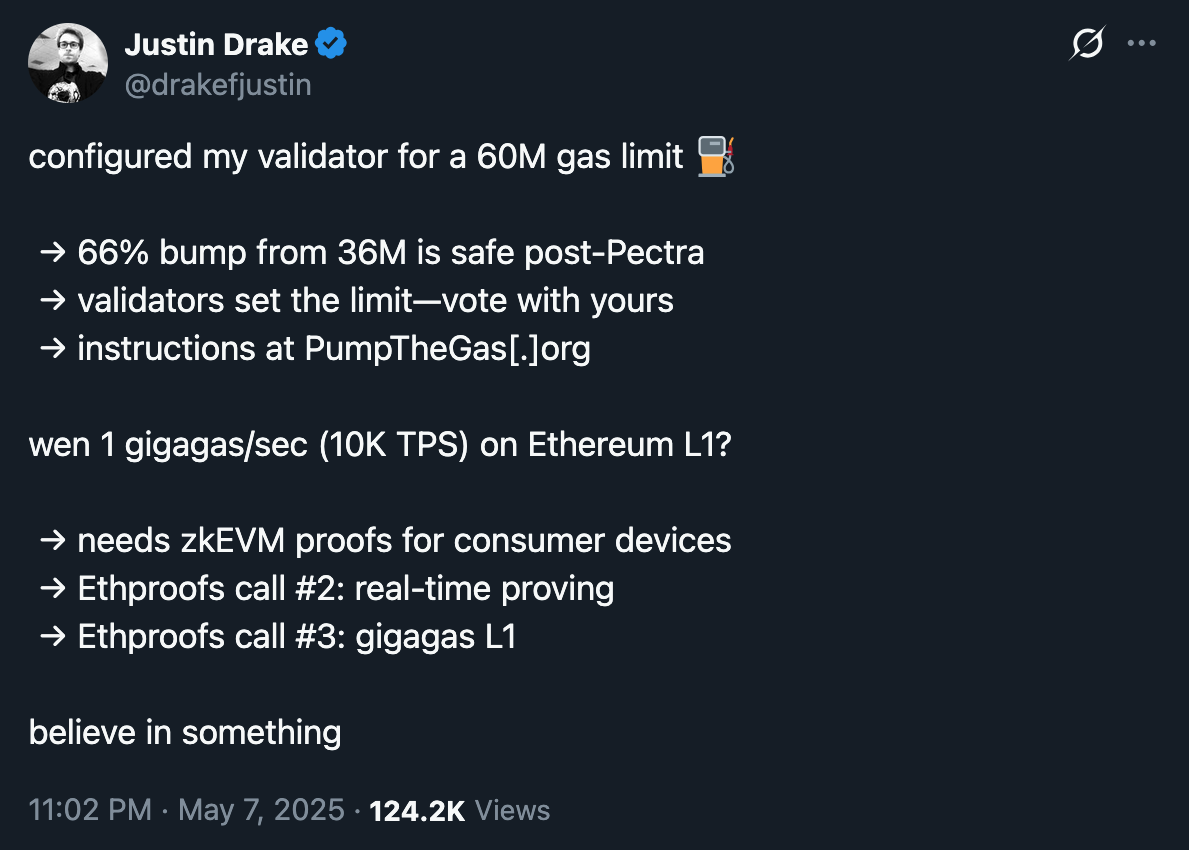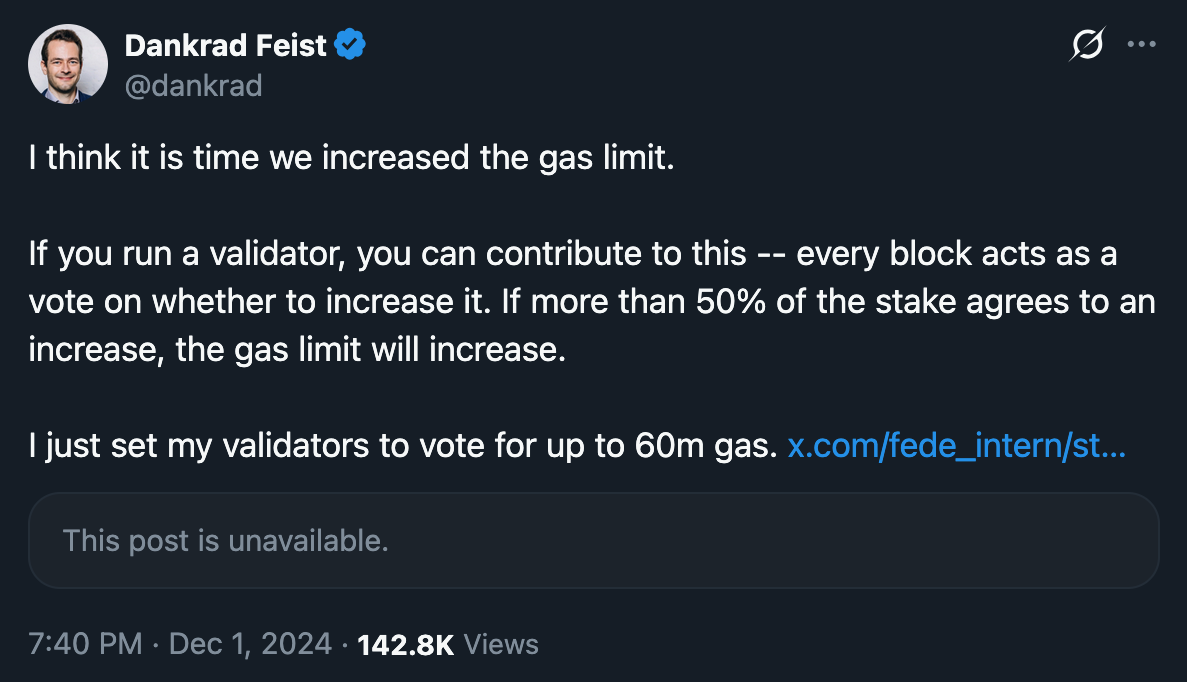Pump the gas is an effort to educate the Ethereum community about the gas limit and how it can be used to help improve Ethereum scaling. Signal your social support and spread our effort on twitter or farcaster. Use the hashtag #pumpthegas
View the current state of gas limit signalling on gaslimit.pics

Justin Drake on Twitter

Dankrad Feist on Twitter

Mariano on Twitter
SOLO STAKERS - What you can do
If you are a solo staker you can increase the gas limit today by adding a flag to your client configuration.
If you use Dappnode you can go to your client package > config > show advanced editor > EXTRA_OPTS
Consensus Client (externally produced blocks)
# Lighthouse (validator client)
--gas-limit 60000000
# Lodestar (validator client)
--defaultGasLimit 60000000
# Nimbus
--suggested-gas-limit=60000000
# Prysm (validator client)
--suggested-gas-limit 60000000
# Teku
--validators-builder-registration-default-gas-limit=60000000
Execution Client (locally produced blocks)
# Besu
--target-gas-limit 60000000
# Erigon
--miner.gaslimit 60000000
# Geth
--miner.gaslimit 60000000
# Nethermind
--Blocks.TargetBlockGasLimit 60000000
# Reth
--builder.gaslimit 60000000
After changing your configuration, you should restart your client.
Validator Check
Check if a validator is ready for the gas limit increase:
CLIENT TEAMS - What you can do
Increase the gas limit to 60000000 in your client so
it's the default in future releases.
This will by far be the most effective way to make sure everyone is running clients with this configuration.
BIG POOLS - What you can do
Increase the gas limit to 60000000 in all your
clients.
FAQ
What is the gas block limit?
Understanding 'gas' is fundamental to understanding how the Ethereum network functions.
The EVM - the Ethereum Virtual Machine (EVM) running on each Ethereum node - is an emulation of a computer system. One example of a regular, non-blockchain virtual machine is the VirtualBox software, which allows you to emulate computer systems (guests) on your physical hardware (hosts). Any operation in the EVM consumes CPU cycles, disk access, memory, of the hosting machine (which carries a cost). This cost is paid via Ethereum 'gas'.
In order to prevent "overload" of the host, each operation on the EVM consumes a certain amount of gas. Accessing memory or writing to disk have differing costs with each EVM operator setting an upper limit to the gas consumed during execution of a contract. So, if a malicious operator crafted a smart contract that went into an infinite loop, each loop would consume some gas and eventually run into the limit, at which point the EVM would abort the execution of this contract. Essentially, the larger, more complex the contract and the more operations it performs, the more expensive it is to run it.
There are many key components to a transaction that are important to understand:
| Term | Description |
|---|---|
| Gas | Unit for how much computation work is done. |
| Gas Price | How much you're willing to pay per gas for work (in gwei) |
| Tx Cost | Gas used * Gas Price |
| Gas Limit | Max gas you'll pay for a certain tx |
| Gas Block Limit | Max gas allowed in a block |
What is the current gas block limit?
60,000,000, increased from 45 M on November 26, 2025
What is the current recommendation for the gas block limit?
60,000,000
Why this recommendation?
This is based on extensive benchmarking and testing.
What's our next target and how do we get there?
100,000,000
This is a significant increase from the current 60 M and will depend on client optimizations and testing. Continuous pushing by the community for these optimizations helps Ethereum reach this target faster. It's possible that the next target will land somewhere between 60 and 100 M.
How does this help Ethereum?
Raising the gas block limit gives Layer 1 Ethereum the ability to process more transaction load in a day. This has the potential to lower gas fees on L1. Prior to recent raises, it was estimated that a shift from 45 to 60 M gas could reduce tx fees ~10-30%.
What about blobs?
Blobs (EIP-4844) help greatly reduce Layer 2 transaction fees, not Layer 1 transaction fees. A combination of blobs + gas limit increase can help scale both L1 and L2 Ethereum.
Why not go even higher?
It's important to remember that one of the core goals of Ethereum is to remain as decentralized as possible. If the gas limit is raised too high we could create a scenario where the chain becomes too large for solo node operators to validate and download. Technology improves however and it does make sense to slowly increase it as time goes on. Another important factor to consider is if we raise it too fast, we may run into unexpected externalities, beyond just storage and bandwidth requirements.
What can we do to make gas increases safer?
We think there are 2 EIPs that are very important to allowing even further increases in the future. These are EIP-7623 and EIP-4444, both of which the Ethereum community should seriously consider.
How can I view the progress of this effort?
You can view the latest blocks with a gas limit at 60 M at Blockchair. You can also see a bar chart over at Dune.
I'm in, how can I help?
If you're a validator, you can set flags on your execution clients and consensus clients to signal that you'd like to raise the gas limit. Please see above for these flags.
Further Reading
Paradigm - How to Raise the Gas Limit, Part 1: State Growth
Ethereum Research - On Block Sizes, Gas Limits and Scalability
pumpthegas.org
Made by @econoar & @nanexcool (who loves big blocks and loves you)
Mariano wants you to send a PR to make this website prettier please